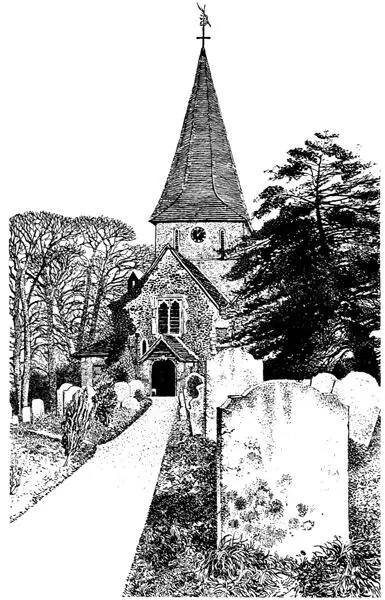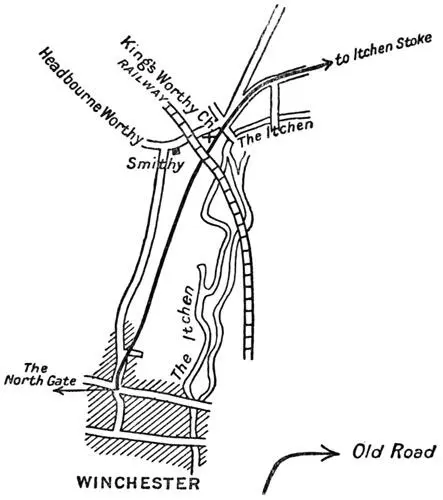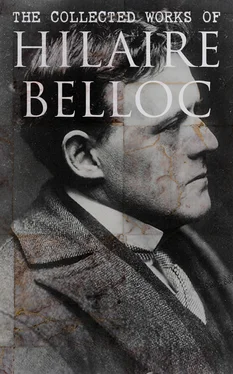IV. Wherever the Road goes right up to the site of a church it passes upon the southern side of that site.
It is necessary to digress here for a moment upon the archæological importance of these sites. They are but an indication, not a proof, of prehistoric sanctity. It would be impossible to say in what proportion the old churches of these islands stand upon spots of immemorial reverence, but it is certain that a sufficient proportion of them do so stand (the church of Bishopstoke, for instance, upon the site of a Druidical circle), as to afford, when a considerable number are in question, a fair presumption that many of the sites have maintained their meaning from an age long prior to Christianity. Apart from the mass of positive evidence upon this matter, we have our general knowledge upon the methods by which the Faith supplemented, and in part supplanted, older and worse rituals; and there is an impression, which no one who has travelled widely in western Europe will deny, that the church of a place has commonly something about it of the central, the unique, or the isolated in position; characters which cannot wholly be accounted for by the subsequent growth of the community around them.
Now, on its way from Winchester to Canterbury, the Old Road passes, not in the mere proximity of, but right up against, thirteen existing or ruined churches. They are, proceeding from west to east, as follows: King's Worthy, Itchen Stoke, Bishop Sutton, Seale, Puttenham, St. Martha's, Shere, Merstham, Titsey, Snodland, Burham, Boughton Aluph, and Chilham. 7In the case of eight it passes right up against the south porch; in the case of two (Bishop Sutton and Seale) it is compelled to miss them by a few yards. One (St. Martha's) is passed on both sides by a reduplication of the track. One (Chilham) is conjectural, and the last (Shere) is doubtful.

THE CHURCH OF SHERE
The habit is the more remarkable from the fact that the Road commonly goes north of a village, and therefore should, unless it had some purpose, commonly go north of all churches. And, indeed, it does pass many churches to the north, but it always leaves them (as at Chevening, Lenham, Charing, and the rest) to one side. It never goes close to their site.
The importance of this rule will be apparent when we consider, later on, the spots in which a church stands, or has stood, and where, at the same time, the track is doubtful and has to be determined.
V. In crossing a river-valley, the Road makes invariably for the point where spurs of dry ground and rising ground come closest upon either side, and leave the narrowest gap of marshy land between.
I note this as a characteristic of the Road, quite apart from the more obvious considerations; such as, that primitive man would seek a ford; that he would seek gravel rather than clay; that he would try to pass as high up a river as possible, and that, other things being equal, he would keep to the general alignment of his path as much as possible in crossing a river. All these are self-evident without the test of experience, but this characteristic of which I speak is one that would not occur to a traveller who had not tested it with his own experience. It is so at the crossing of the Itchen, at the crossing of the Wey, at the crossing of the Mole, at the crossing of the Darent, and, as we shall see, it is useful in giving us a clue towards the much more important crossing of the Medway.
VI. Where a hill must be taken, it is taken straight and by the shortest road to the summit, unless that road be too steep for good going.
Here one has something to be found all over England where an old, has been superseded by a modern, way. I have an instance in my mind on the main road westward from Tavistock into Cornwall. It is exactly analogous to what the Indian trails in America do to the present day. It is civilisation or increased opportunities—especially the use of wheeled traffic on a large scale—which leads men to curve round a hill or to zig-zag up it. In the course of the Old Road there are not many examples of this. From the nature of the ground which it traverses the hills to be surmounted are few; but when they do come, the knowledge of this habit will lead one always to prefer the straightest of two ways of reaching the summit.
VII. A similar tendency causes the Road to seek, as immediately as possible, when it is passing from one valley to another, the saddle of the watershed, if that watershed be high.
Of this there is but one example in the Old Road, that near Medstead in Hampshire. It therefore affords us no particular clue in dealing with this road alone, but as we know that the same phenomenon is apparent in the remaining prehistoric tracks, and in existing trails in savage countries throughout the world, it is a valuable clue, as will be seen later in the particular instance of the saddle between the valleys of the Itchen and the Wey.
Prepared for such a method; having well marked our maps and read what there was to read; having made certain that the exact starting-point was the site of the North Gate at Winchester, and that the first miles went along the right bank of the Itchen, we two went down from town before December ended, choosing our day to correspond exactly with the dates of the first pilgrimage. When noon was long past, we set out from Winchester without any pack or burden to explore the hundred and twenty miles before us, not knowing what we might find, and very eager.
THE EXPLORATION OF THE ROAD
Table of Contents
THE EXPLORATION OF THE ROAD
Winchester to Alton
Eighteen miles and a half
Winchester differs from most other towns which the Romans reorganised in that its main streets, the street north and south and the street east and west, do not divide the city into four equal quarters. The point where the two ways cross is close to the western wall, and this peculiar arrangement was probably made by the first conquerors in order to avoid an exit upon the marshy land beside the Itchen; for that river flowed just against the eastern wall of the city.
Of the four arms of this cross, the northern, a street always given up to commerce, became, in the later Middle Ages, the Jewry. By a process at first perhaps voluntary, but later legal, the Jews were concentrated into one quarter, a sort of Ghetto. It is to be noticed that in nearly every case these Jewish quarters were in the very thick of a city's life, and (as in the Paris of Philippe le Bel) of far greater value than any other equal area of the city. 8Something of the kind was present at Winchester. The whole stream of traffic which passed out from the capital to the rest of England went through the lane of the moneylenders, and we may say with certitude that the north gate, the limit of that lane, was the starting-point of the Old Road.
The north gate has now disappeared. It lay just south of the grounds now known as North-Gate House. The deflection of the street is comparatively modern; the original exit was undoubtedly (as at Chichester and elsewhere) along the straight line of the Roman road. This passed near the site of the present house, and pointed towards the isolated tree which marks the northern edge of the garden.

From this point it has been commonly imagined that the Old Road must have coincided with the modern Hyde Street, and have followed this line as far as the smithy at Headbourne Worthy. Thence it has been supposed to branch off to King's Worthy.
Читать дальше














